
|   |

|   |
Natyanubhava - A film by Sharada Ramanathan - Dr. Sunil Kothari e-mail: sunilkothari1933@gmail.com Photos courtesy: Sharada Ramanathan July 7, 2014 Produced with the assistance of Public Service Broadcasting Trust (PSBT), which is a Public Diplomacy initiative of the Ministry of External Affairs, Govt of India, Natyanubhava, a documentary on classical dance forms of India by the renowned film maker Sharada Ramanathan was screened at Gulmohor, India Habitat Centre, on 3rd July. A large number of dance aficionados were present as were some of the dancers who are featured in the film like Kathak exponents Abhimanyu Lal and his wife Vidha Lal, young Kuchipudi dancer Sandhya Raju, who specially came from Hyderabad for the screening. Saswati Sen and Geetanjali Lal, both senior Kathak dancers and gurus, were also present and at the end they all were felicitated by PSBT organizers. Former Foreign Secretary and Ambassador to USA Lalit Mansingh, photographer Avinash Pasricha, Professor Amrit Srinivasan, music and dance critic Manjari Sinha, senior Bharatanatyam dancer Jamuna Krishnan and her daughter Ragini, and many young Kathak dancers were present. It was heartening to see the full house and many standing near the wall of the hall at the back, watching the film. The entry was free, unlike the three screenings in Satyam cinema in Chennai, which were ticketed shows. 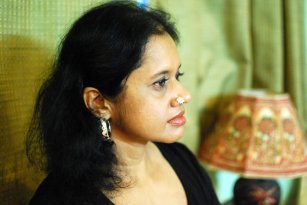 Sharada Ramanathan 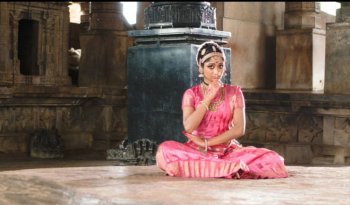 Sandhya Raju Recently, a stuntman working for Sharada Ramanathan's latest film 'Puthiya Tiruppangal' under production had observed: "When you look like a mayil (peacock) from Mylapore with that mookuthi (nose-ring), how can I imagine you as the director, Madam?" Sharada wears the nose-ring proudly, as she has inherited it from her grandmother. It lends her a distinct personality. Sharada, now based in Chennai is a film maker not only of documentary films, but also of full length feature films. Her feature film 'Sringaram-Dance of Love' has been featured in international film festivals at Dubai, New York, Kerala and Los Angeles, and won three national and two state film awards in India. Sharada has lived in New Delhi and was closely associated with Ford Foundation, The India Foundation for the Arts, Bangalore. She is also associated with SPIC MACAY and is a board member of the World Culture Forum-India. She is a widely published author on culture and development. A dynamic person, Sharada is deeply steeped into classical Carnatic music and dance form like Bharatanatyam. 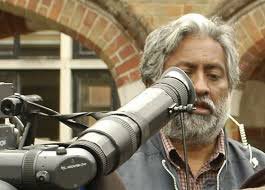 Madhu Ambat
The film is divided into two segments: Darshana (the seen and unseen) and Yatra (journey). The first dwells on dance of Lord Shiva, its spiritual content, his various activities, the pancha bhutas (the five elements), the churning of the ocean as the first dance-drama, the creation of Natya Sastra, how from four Vedas the elements were taken and the fifth Natya Veda was created. Dancers from Chidambaram Academy of Performing Arts of Chitra Visweswaran show the churning of the ocean in Bharatanatyam. The tandava and lasya elements are demonstrated by Chitra Visweswaran to Ardhanareeshwara, alternating between both aspects. The commentary gives one an idea of the historical, philosophical, speculative and spiritual aspects of Indian classical dance. That section is interestingly handled. Interspersing other sequences are stories from mythology. The game of dice is enacted in Kuchipudi by young dancer Sandhya Raju impersonating the roles of Shakuni and Yudhisthira, and is intercut in sequence of Draupadi's disrobing with Kathak dancing duo Abhimanyu and Vidha Lal. Abhimanyu sings the song and furthers the story. These are excellent 'cuts' to the face of Vidha as Draupadi, circling round, as Abhimanyu impersonating Dusashana pulls her sari, and again cut to Kuchipudi dancer. These are extremely well shot pieces. 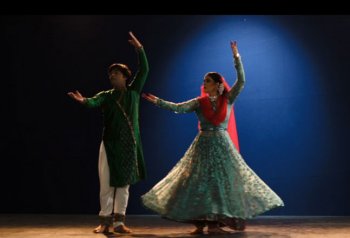 Abhimanyu Lal & Vidha Lal 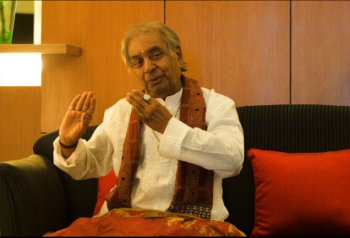 Pt. Birju Maharaj The film moves to legendary Birju Maharaj speaking in Hindi about the dance, its universal appeal, waves of ocean dancing, flowers, trees and branches also waving under gentle breeze, showing with simple hastas (mudras) and comparing the waves rising and receding to the ascending and descending aroha and avaroha of the musical solfa notes. The film covers all the eight classical dance forms ranging from Bharatanatyam, Kathakali, Kathak, Odissi, Kuchipudi, Mohiniattam, Sattriya and also Koodiyattam. There are arresting moments, visually compelling viewers to watch as the film runs. The antiquity of Bharatanatyam is shown with the statue of a woman standing with abhanga pose excavated from Mohenjodaro, juxtaposed with Priyadarsini's similar pose. Guru Kalyanasundaram tells how his father Kuppaiah Pillai and his elder brother Mahalingam Pillai, brother-in-law Govindaraj Pillai and the entire family from Tiruvidaimarudur village have kept tradition alive, even after moving to Mumbai, how dance technique is transmitted. Photos of old great gurus are shown and camera captures Kalyanasundaram showing some dance poses when standing. There are old photographs of devadasi dancers and in one shot a traditional dancer is shown performing. The script was a result of Sharada Ramanathan brainstorming with Chitra Visweswaran and S. Janaki (Executive Editor of Sruti magazine) who did the research for the film and Sharada edited it. Chitra explains the basic three divisions: nritta, pure dance, with camera focusing on pure dance movements in Bharatanatyam and cuts to Odissi at Nrityagram with Surupa Sen and Bijayini Satpathy dancing. Nritya, abhinaya has glimpse of Priyadarsini Govind expressing agony to the padam Payyada pai meede jeri, a mature woman being spurned by her lover. In Odissi, sakhi tells Radha not to delay and go unto Krishna, Surupa and Bijayini performing at Nrityagram. Kapila Venu, doing make up speaks of the slow pace, in contrast to too much of fast running around while dancing, seeking inward peace in a form like Koodiyattam. The nine rasas are demonstrated by Priyadarsini, Kalamandalam Gopi and Sadanam Balakrishnan. Sattriya dancers Bhabananda, Mallika Kandali, Mridusmita Das give small snippets of Sattriya, recognized as the eighth classical dance form in the year 2000. Mohiniattam is shown by Nimmy Raphael of Veenapani Chawla's Adishakti at Puducherry. A young bright sprightly dancer from Hyderabad Sandhya Raju performs Kuchipudi on a brass plate and also Krishna sabdam with uninhibited sringara. In Imphal, Guru Thanil Singh and Manipuri Arts Laboratory show Manipuri Rasaleela in typical colourful costumes. Ileana Citaristi, the Odissi dancer, speaks of her journey from Italy to Orissa and how at Guru Kelucharan Mohapatra's residence she studied dance, which was an organic way of life. Guruji used to observe his wife preparing chappatis and how he used those movements in 'Kuru yadu nandana' ashtapadi from the Gita Govinda, when Krishna prepares sandal paste to place on the breasts of Radha. Mrinalini Sarabhai gives a glimpse of abhinaya and Mallika speaks of how her mother had to overcome various hurdles in early fifties to bring Bharatanatyam and Kathakali to Western part of India, when she moved to Ahmedabad after marrying scientist Vikram Sarabhai. Now their dance academy Darpana lays emphasis on contemporary issues in dance. The film also shows how at Kalakshetra training is given in dance as per the Natya Sastra texts, at the sprawling Kalakshetra campus. In the open air class, guru Janardhanan is shown teaching the eye movements standing near a disciple. The hastas are taught and various charis are demonstrated by three male dancers. 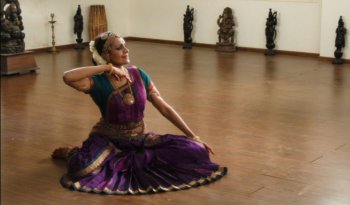 Priyadarsini Govind 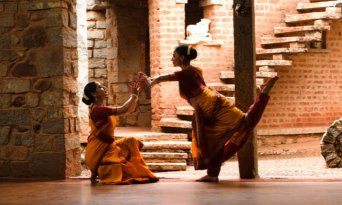 Surupa Sen and Bijayini Satpathy An interesting segment is shown of Birju Maharaj rendering mnemonic syllables of Kathak to tell a story of two friends: one lazy bum, the other quite opposite of him, asking him to go and eat. The lazy one acts yawning with slow syllables and the energetic one asks him to hurry up. Both the characters come alive through bodily movements and facial expressions. This is the most favourite piece of abhinaya Birju Maharaj has often performed and it has been shown live so many times. The audience watching this on film also responded laughing. Another piece was of a khandita nayika, enraged at the lover returning to her after spending the night with the other woman: The thumri by Bindadin Maharaj Kahe ko mere ghar aye ho? - why have you come back? - is enacted by Birju Maharaj singing and registering expressions of the offended nayika showing the telltale marks of having spent the night with the other woman, the crumpled dress, the black of the eye on lips, the long hair found on his body and so on. Without explaining the textual meaning and sanchari bhavas, improvisation, just sitting on a sofa, Birju Maharaj performs with complete ease. Sharada later on during Q and A admitted that she should have placed sub-titles for the Hindi in which Birju Maharaj speaks. He sings also and there is no accompaniment of even a tanpura. However, music critic Manjari Sinha felt that there was a tanpura which was incorrectly tuned when he sang. Sharada however said that she had not super imposed any instrumental music when Birju Maharaj sang. Though for explaining Natya Chitra speaks of many characters playing different roles, the natya aspect was shown with Koodiyattam by Kapila Venu and a solo Kathakali by I think Sadanam Balakrishnan. Having covered all dance forms through excerpts the film ends with Ananda, joy practically covering all dance forms. The narrative is more through visuals. That is where the film scores. It is a cinematic language which captures the different dance forms with excellent lighting and angles. Often the lighting is done in a manner that the faces of dancers are not seen. Photographer Avinash Pasricha said that if the PSBT films were essentially made for television screenings, then this lighting was not appropriate. Despite that observation, one feels that the film is shot exquisitely and leaves beautiful images in one's inner eye to relish. For someone who has been watching dance scene for the past 50 years, recognising dancers and dance forms was easy. Therefore even when the narrative appeared disjointed, the visual aspect of the film, camera work by Madhu Ambat, the superb lighting, at times using the historic location etc., and performances by the dancers was a visual feast. During the Q and A session too many questions were put to Sharada. One realised that she knew it was a difficult film to produce since narrative appeared disjointed. There were two aesthetics of 'yore' - past - and 'of now.' She recalled what artist Anjoli Ela Menon had told her: "We live in India several centuries at the same time. No other civilization is so living reflecting so many facets of the past and the present." Sharada explained that she saw the body as a metaphor, like garbhagriha (sanctum sanctorum) of a temple, the womb from which fertility springs. The artists performing were all so well immersed in their art and often the camera was just asked to 'roll' to capture the mood and movement. Sharada had not much difficulty to explain to dancers, who understood what she wanted and also what the cameraman was aiming at. Birju Maharaj has enough experience having directed dance in films latest being 'Vishwaroopam.' Sharada found it heartbreaking when on editing table some scenes had to be edited and cut to remain within time frame of 52 minutes. She had remarked earlier in Chennai while screening the film that she was trying to tell story of 5000 years of civilization in 52 minutes in the film. Such films are most expensive and cost more than the planned budget. The advantage was that there was ready infrastructure available to her for editing, said Sharada, using latest technological advanced facilities having produced and directed 'Sringaram' with Madhu Ambat. Lalit Mansingh complimented Sharada for reverting back to art films from commercial films. Sharada said that she can work for both art documentary films and also commercial films. As a matter of fact her next film 'Puthiya Tiruppangal' is commercial on the subject of child trafficking. On being asked if she were to make a sequel of Natyanubhava, as she has lot of unused stock filmed, she said that it would be expensive and was not sure if she would undertake a sequel. She thanked the artists who gave their time and beautiful performances for the film. The mutual understanding and friendship developed during the shooting of the film and being together has strengthened their friendship and mutual respect.  Dr. Sunil Kothari is a dance historian, scholar, author and a renowned dance critic. He is Vice President of World Dance Alliance Asia Pacific India chapter, based in New Delhi. He is honored by the President of India with Padma Shri, Sangeet Natak Akademi award and Senior Critic Award from Dance Critics Association, NYC. He is a regular contributor to www.narthaki.com, the roving critic for monthly magazine Sruti and is a contributing editor of Nartanam for the past 12 years. Post your comments Pl provide your name and email id along with your comment. All appropriate comments posted with name and email id in the blog will also be featured in the site. |